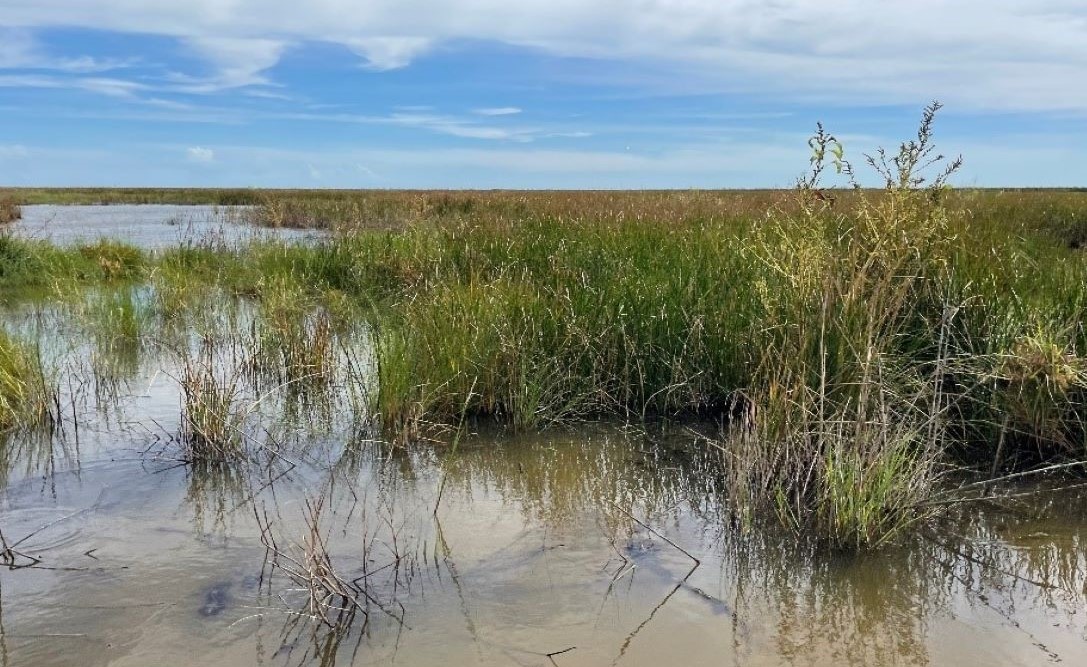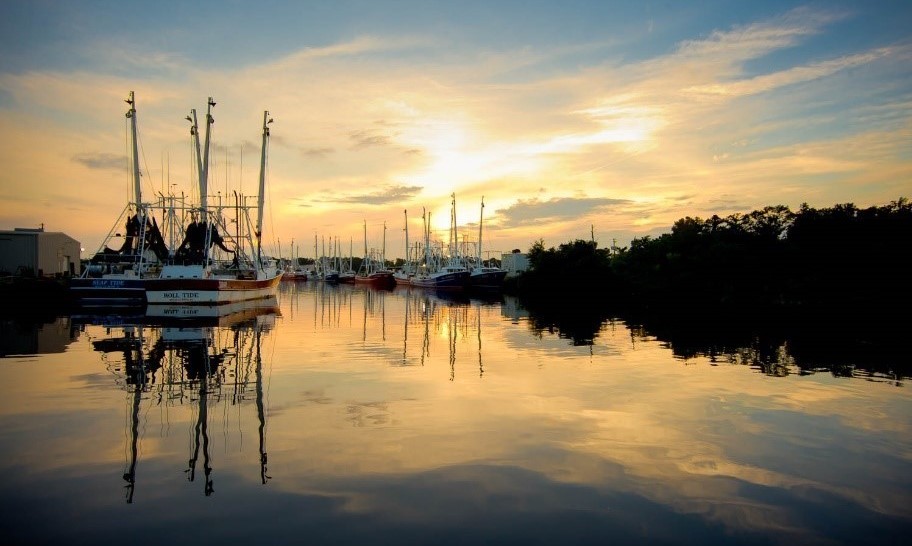NEW WEBINAR SERIES ON PROMISING PRACTICES AND RESEARCH FROM TREASURY-FUNDED RESTORE PROJECTS
Treasury's Office of Gulf Coast Restoration has launched a brand-new webinar series highlighting promising practices and research that provide for the long-term health of the ecosystems and economy of the Gulf Coast. The first webinar was held on March 7, 2022, with the theme “Leveraging Treasury RESTORE Funds to Support Climate Resilience” and featured two presentations:
- Dr. Marla Nelson of the University of New Orleans who presented on her RESTORE Centers of Excellence-funded research From Adapting in Place to Adaptive Migration: Designing and Facilitating an Equitable Relocation Strategy
- Mr. Hank Hodde from Pinellas County, Florida who presented on the results and application of the report and tool developed under the County's RESTORE Direct Component award Pinellas County Assessment of Vulnerability to the Impacts of Sea Level Rise & Infrastructure Resiliency Plan.
We invite you to view and share a recording of the webinar.



Images (top to bottom): 1) Flooded marsh in Louisiana’s Cameron Prairie National Wildlife Refuge. Photo taken October 2021 by Coastal Protection and Restoration Authority. 2) Shrimp boats docked in Bayou la Batre, Alabama. Photo by Billy Pope, provided by Alabama Department of Conservation and Natural Resources. 3) Erosion caused by Hurricane Zeta in coastal Mississippi. Photo by Sam St John.
The U.S. Department of Treasury’s Office of Gulf Coast Restoration (OGCR) administers two grant programs, the Direct Component and Centers of Excellence, designed to rebuild the economy and ecosystems of the U.S. Gulf Coast. These programs were created by The Resources and Ecosystems Sustainability, Tourist Opportunities, and Revived Economies of the Gulf Coast States Act (RESTORE Act), which was signed into law on July 6, 2012 and is funded by civil and administrative penalties from the 2010 Deepwater Horizon oil spill.
While the RESTORE Act does not use the terms “climate change” or “climate crisis,” the Act set forth a wide range of eligible uses for these funds, many of which are directly or indirectly tied to building resilience in the face of climate risks. Many eligible entities under the Act have chosen to use their allocated funds for climate-related eligible uses, such as improving coastal flood protection or funding research into the impact of climate change of the health of Gulf Coast waters and its fish and wildlife.
In this way, Treasury’s RESTORE Act Program supports the President’s January 27, 2021 Executive Order on Tacking the Climate Crisis at Home and Abroad, which directs Federal agencies to increase “resilience to the impacts of climate change” and conserve “our lands, waters, and biodiversity.”
Treasury RESTORE Act Programs also support the Executive Order’s focus on environmental justice. All Direct Component projects must be selected following a public comment process to obtain broad-based participation from individuals, businesses, Indian tribes, and non-profit organizations before the plan is submitted to Treasury for acceptance. In addition, all projects are vetted by Treasury’s Office of Civil Rights and Diversity to ensure recipients comply with all Title VI Civil Rights requirements. Many projects are located in, or directly benefit, communities of color, low-income communities, and/or Native communities.
The Twin Threats Facing the U.S. Gulf Coast: Climate Risk and Development Pressures
The U.S. Gulf Coast has long been buffeted by hurricanes and tropical storms and faces extreme heat, rainfall, and humidity. However, the frequency and severity of storms has been increasing. The year 2020 saw a record-breaking 30 named storms in the Atlantic, nine of which were in the Gulf Coast; the insurance industry has estimated losses at $60-65 billion. In recent memory, Hurricanes Sally and Zeta interrupted many Treasury RESTORE Act recipients’ operations in 2020, and Hurricane Ida was similarly disruptive to many Louisiana parishes in 2021.
The increase in economic losses tied to storm events is not only the effect of increased storms, however. It is also the result of rapid population growth, putting more Americans in harm’s way when a storm event occurs. Although the smallest of the U.S. coastline regions, the Gulf Coast is experiencing the fastest growth of any U.S. coastal region, adding more than 3 million people between 2000 and 2016, an increase of 24.5 percent— or roughly 10 percentage points higher than the U.S. growth rate.
Population pressures have also led to development crowding out natural ecosystems such as marshes that act as protective barriers during flood events. Development has increased impervious surface areas, resulting in increased runoff during storms and heavy rainfalls, which further increases the likelihood and severity of flooding. Runoff carries nutrients from the land to coastal waters and can exacerbate the extent, duration, and intensity of coastal harmful algal blooms – typically referred to as Red Tide in Florida. Other factors that contribute to blooms include warm temperatures, reduced water flow, and storm events. In 2017-2018, southwest Florida experienced an unusually persistent red tide that affected portions of the coast and disrupted multiple RESTORE-funded projects in the region.
Population and economic growth have also contributing to land subsidence, as groundwater, oil, and natural gas are extracted and the ground then sinks. This exacerbates the impact of sea level rise, the result of warmer global temperatures. The combination of subsidence and global sea level rise is leading to substantial coastal erosion and the conversion of dry land, marshes, and fresh water to open ocean. The impact of subsidence is most significant in coastal Louisiana, which loses 75 square kilometers of wetlands every year, about 80 percent of wetland losses in the entire United States.
Many Direct Component Projects Address These Risks
As described in much further detail on the Treasury RESTORE-funded Direct Component Projects and the Climate Crisis page, many eligible entities are focused on one or more of these interrelated challenges. The State of Louisiana, for example, plans to use its entire Direct Component allocation to reduce the conversion of marsh land to open water near the Calcasieu-Sabine Basin.
Other eligible entities under the Act are focused on building up levees and other flood protection structures; increasing the capacity of stormwater systems and constructing retention ponds to handle increased runoff; or rebuilding and strengthening beaches, dune, coral reefs, and other ecosystems that were damaged by recent natural disasters but can play an important role in mitigating the impact of future disasters.
Learn more about the Treasury RESTORE-funded Direct Component Projects and the Climate Crisis
Many Centers of Excellence Fund Research to Evaluate and Mitigate these Risks
As described in much further detail on the Treasury RESTORE-funded Centers of Excellence and the Climate Crisis page, many Centers of Excellence are funding critically important climate-related research. The Alabama Center of Excellence, for example, is directing its RESTORE funding to investigate multiple anticipated stressors, including various aspects of climate change such as ocean acidification and warming. This research will inform Alabama’s stewardship of its marine resources.
Learn more ABOUT Treasury RESTORE-funded Centers of Excellence and the Climate Crisis.
Resources to Estimate Climate Risk
Access our list of resources for those interested in understanding the likely impact of climate change on sea level rise and flood risk in the U.S. Gulf Coast. We encourage our recipients to use these resources as appropriate when selecting, planning, designing, and siting RESTORE-funded projects.